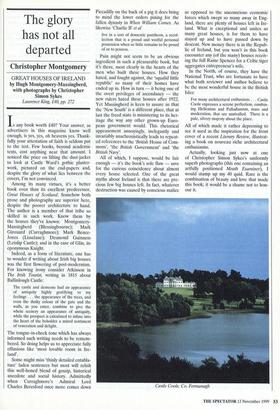The glory has not all departed
Christopher Montgomery
GREAT HOUSES OF IRELAND by Hugh Montgomery-Massingberd, with photographs by Christopher Simon Sykes Laurence King, f40, pp. 272
Is any book worth £407 Your answer, as advertisers in this magazine know well enough, is yes, yes, oh heavens yes. Thank- fully your attestation of faith is seldom put to the test. Few books, beyond academic texts, cost anything near that amount. I noticed the price on lifting the dust-jacket to look at Castle Ward's gothic plaster- work, pictured on the end-papers and, despite the glory of what lies between the covers, I'm not convinced.
Among its many virtues, it's a better book even than its excellent predecessor, Great Houses of Scotland. Somehow both prose and photography are superior here, despite the poorer architecture to hand. The author is a member of that tribe so skilled in such work. Know them by the houses they've known: Montgomery- Massingberd (Blessingbourne); Mark Girouard (Curraghmore); Mark Bence- Jones (Lisselane); Desmond Guinness (Leixlip Castle); and in the case of Glin, its eponymous Knight.
Indeed, as a form of literature, one has to wonder if writing about Irish big houses was the first flowering of post-modemism. For knowing irony consider Atkinson in The Irish Tourist, writing in 1815 about Bailinlough Castle:
The castle and demesne had an appearance of antiquity highly gratifying to my feelings ... the appearance of the trees, and even the dusky colour of the gate and the walls, as you enter, combine to give the whole scenery an appearance of antiquity, while the prospect is calculated to infuse into the heart of the beholder a mixed sentiment of veneration and delight.
The tongue-in-cheek tone which has always informed such writing needs to be remem- bered. So doing helps us to appreciate fully effusions like 'most lovable room in Ire- land'.
Some might miss 'thinly detailed entabla- ture' laden sentences but most will relish this well-honed blend of gossip, historical anecdote and social history. Admittedly when Curraghmore's Admiral Lord Charles Beresford once more comes down
Piccadilly on the back of a pig it does bring to mind the lower orders pining for the fallen dynasty in When William Comes. As likewise 'Charlie B' et al
live in a sort of domestic pantheon, a recol- lection that is a proud and wistful personal possession when so little remains to be proud of or to possess.
Pain might not seem to be an obvious ingredient in such a pleasurable book, but it's there, most clearly in the hearts of the men who built these houses. How they hated, and fought against, the 'squalid little republic' so many of their homes have ended up in. How in turn — it being one of the overt privileges of ascendancy — the new rulers hated these houses after 1922. Yet Massingberd is keen to assure us that the 'New South' is a different place, that at last the freed state is ministering to its her- itage the way any other grown-up Euro- pean government would. This rhetorical appeasement annoyingly, inelegantly and invariably anachronistically leads to repeat- ed references to the 'British House of Com- mons', 'the British Government' and 'the British Navy'.
All of which, I suppose, would be fair enough — it's the book's sole flaw — save for the curious coincidence about almost every house selected. One of the great myths about Ireland is that there are pre- cious few big houses left. In fact, whatever destruction was caused by conscious malice as opposed to the unconscious economic forces which swept so many away in Eng- land, there are plenty of houses left in Ire- land. What is exceptional and unites so many great houses, is for them to have stayed up and to have passed down by descent. New money there is in the Repub- lic of Ireland, but you won't in this book encounter any (of the many) houses receiv- ing the full Raine Spencer for a Celtic tiger aggregates entrepreneur's wife.
In the North, of course, they have the National Trust, who are fortunate to have what both reviewer and author believe to be the most wonderful house in the British Isles:
For many architectural enthusiasts ... Castle Coole expresses a serene perfection, combin- ing Hellenism and Palladianism, mass and moderation, that are unrivalled. There is a pale, silvery majesty about the place.
All of which made it rather depressing to see it used as the inspiration for the front cover of a recent Literary Review, illustrat- ing a book on nouveau riche architectural enthusiasms.
Actually, looking just now at one of Christopher Simon Sykes's uniformly superb photographs (this one containing an artfully positioned Meath Examiner), I would stump up my 40 quid. Rare is the combination of beauty and love that made this book; it would be a shame not to hon- our it.
Castle Coole, Co. Fermanagh


























































































 Previous page
Previous page